If you’re a frequent road bike rider, a good general rule is that you should pump your tires at least once or twice a week. But if you don’t go out that often, before every ride is probably a good idea. Road bike tires will lose pressure relatively quickly (even after just four or five days of sitting), so it’s a good idea to check your bike tire pressure in Boca Raton, FL frequently and make the adjustments as needed. In most cases, road bike tires should fall somewhere between 80 and 130 psi.
But why is it that bike tire pressure can change so quickly? It doesn’t matter what kind of bike tire you have (tubed or tubeless)—the pressure will go down naturally over time, even if there’s not an air leak somewhere in the rubber. The higher the pressure, the more likely the air will force itself out. When you consider that road bike tires have a relatively low volume of air, even small amounts of air leaving the tire will result in a fairly sizable percentage of the total air leaving.
Temperature affects tire pressure in bikes just as it does in cars. Tire pressure will always increase and decrease with the outdoor temperature. If you fill up your tires in a cool garage but are out riding on hot pavement, the pressure of the tires will go up on your ride. While this increase won’t be extremely large, it’s still something you’re going to want to take into account when filling up your tires before a ride.
It’s important that you have your tires set to the right pressure when riding your bike. Riding with a tire pressure outside the recommended range can cause damage to those tires. If your tire pressure gets low enough, it becomes more likely you’ll puncture the tube inside of it.
You don’t need a fancy bike pump—a cheap floor pump will do. Remember, though, that when pumping up your tires, you can pop the tire by over-pressurizing it. You don’t have to use a pump to check your tire—you can compress the tire by pressing down hard on it with your finger or by sitting on the bike. You shouldn’t be able to compress it very much with your finger, and when you sit on the bike, there shouldn’t be an extremely noticeable compression of the tire.
You shouldn’t be able to compress it very much with your finger, and when you sit on the bike, there shouldn’t be an extremely noticeable compression of the tire.
You can also use an actual tire pressure gauge, which you can find cheap at bike repair shops or online. Press the gauge into the valve and you’ll get a pressure reading. This is faster than having to pull out the whole pump. You can find both digital and analog pressure gauges.
These are just a few issues you’ll need to take into consideration as a road bike owner. It’s crucial that you do what you can to maintain your tires and the proper bike tire pressure in Boca Raton, FL. For more information, contact the team at Bicycle Doctor House Calls.
Categorised in: Bicycle Maintenance
This post was written by Writer
I’m not too proud to admit that I’ve had to walk a bike home with a completely preventable flat tire.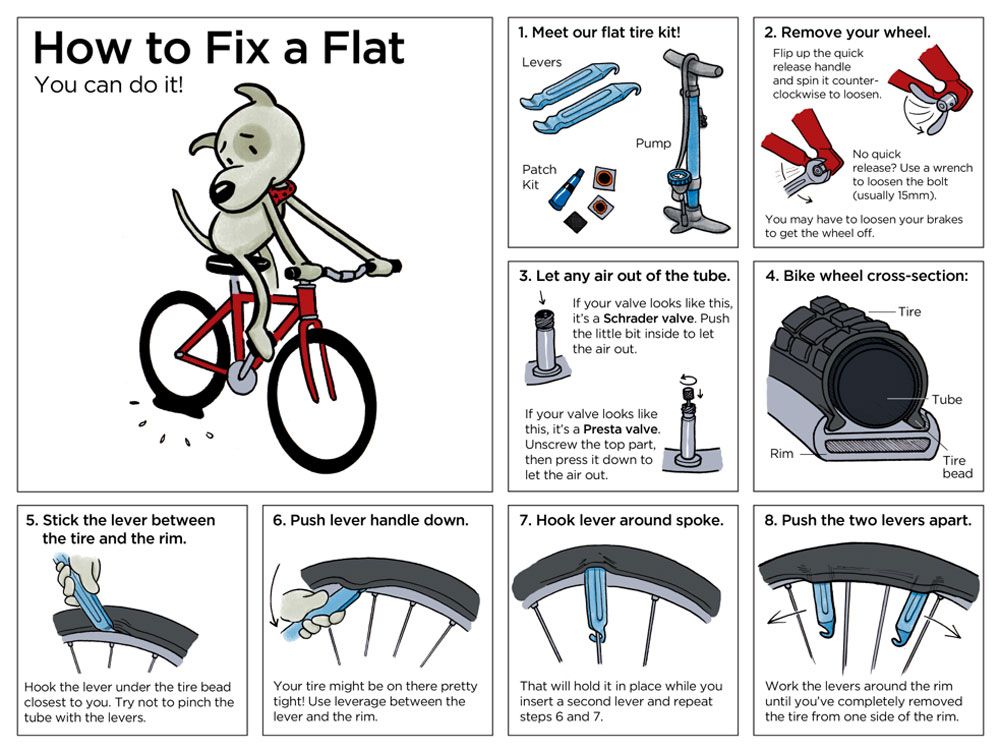 I’ve learned since then about the importance of checking your tire pressure.
I’ve learned since then about the importance of checking your tire pressure.
You should pump up your road bike tires at least once or twice a week, or before every ride if you don’t go out that often. Road bike tires have been known to lose pressure after 4-5 days of sitting still. I’ve been surprised with small leaks before, so I check mine before every long ride regardless of when my previous ride was.
Your tires should be somewhere between 80 and 130 psi. Here is a link to my post about how to pick the right tire pressure for you and your ride.
The pressure in your tires will naturally go down over time, whether they have tubes or are tubeless. Neither system is perfect, and they both slowly leak air. This makes sense because road bikes have very high pressures.
The higher the pressure, the more likely that the air will find a way to leak out. As well, road bike tires have a relatively small volume of air in them.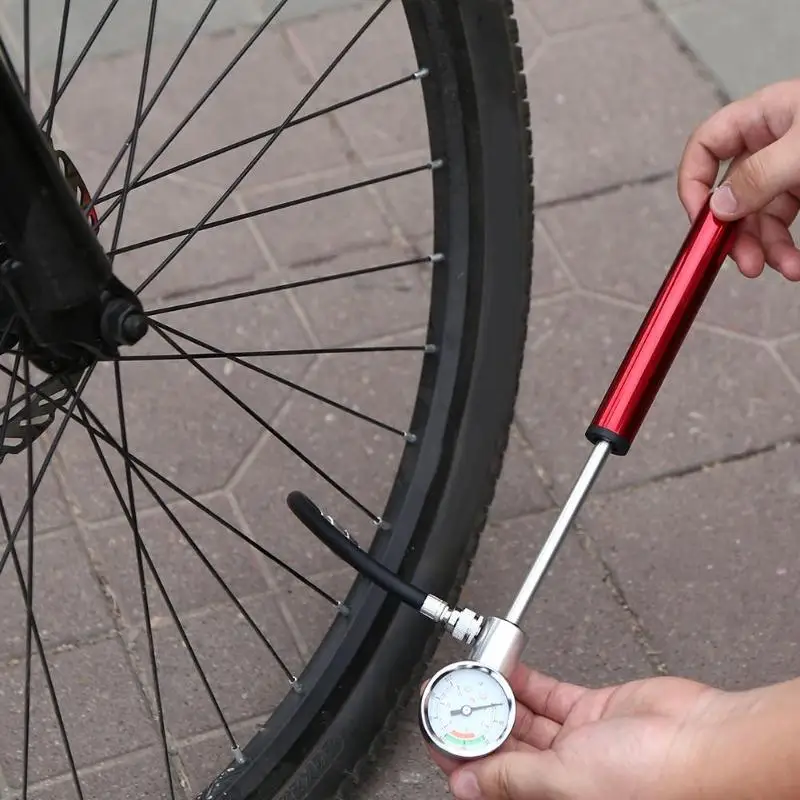 So, even if only a little bit of air has leaked out, it means that a larger percentage of the total air is gone.
So, even if only a little bit of air has leaked out, it means that a larger percentage of the total air is gone.
The temperature can also affect the pressure in your tires. For a given volume of air, the pressure will increase and decrease along with temperature. So, If you filled up to the right pressure in a cool garage, but you are out riding on piping hot pavement, expect the pressure in your tires to go up.
Thankfully, this doesn’t have a huge affect on the pressure. However, there have been occasions where people left their bikes baking in the hot sun, and their tires popped after getting too hot.
Riding your bike with the right tire pressure is very important. While tuning the pressure within a certain range will get you minimal returns, having a pressure outside of that range can actually cause damage. Riding with a low tire doesn’t just slow you down, it also wear out your tube and tire really fast. If your pressure gets low enough, you’re more likely to puncture the tube than you are to enjoy your ride.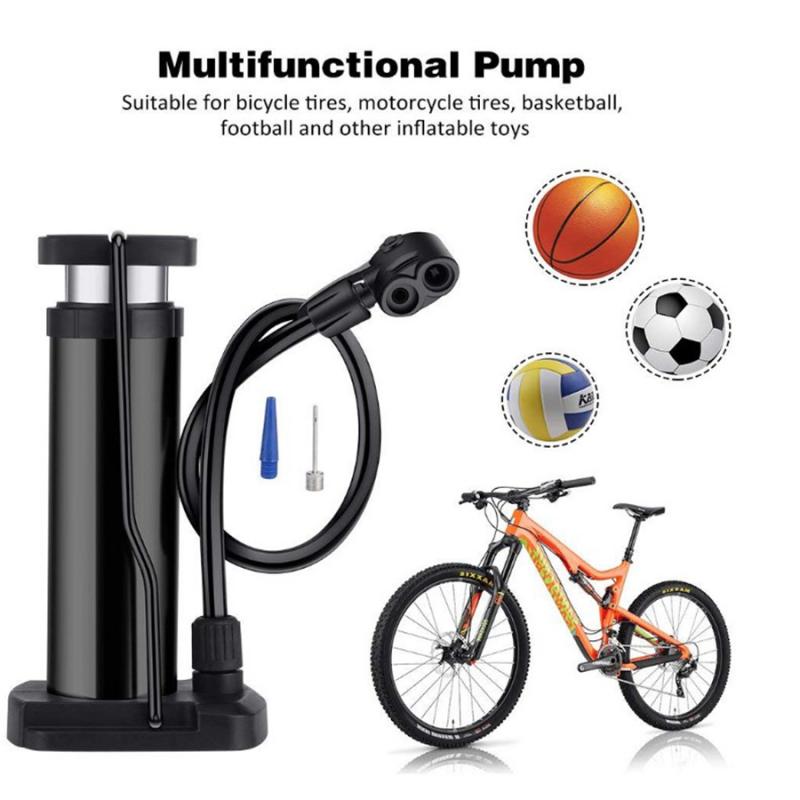
All of the different problems really just result in an increased amount of maintenance. You’ll need to buy more tubes, buy more tires, install them yourself, or go to a shop and pay someone to install them for you.
Investing in a cheap floor pump and using it regularly can pay for itself. Plus, taking more control over your tire pressure can result in a more enjoyable and safer ride! Click here to read a post about picking a good tire pressure for your road bike.
My suggestion is that you have a floor pump and you pump up your tires before every ride. Here is a link to check the price on Amazon. Make sure that you pick one with a pressure gauge. Getting it to the right pressure should be straight forward as long as you are paying attention.
Just remember that you can pop a tire by pressurizing it too much. There are ways to check your pressure without pumping, though.
Compressing the tire, either by pressing hard with a finger or by sitting on the bike, is a fast and free way to check your pressure. It should compress very little under your finger, and a bit more when you sit on it. Not very much, but definitely some.
It should compress very little under your finger, and a bit more when you sit on it. Not very much, but definitely some.
he ideal amount of “squish” derived by cycling scientists is 15% of the thickness of the tire. That’s hard to eyeball, though. As long as it gives a little bit, but not more than a few millimeters, then you should be okay.
The more official way to check the pressure without using a pump is to get an actual tire pressure gauge. Here’s a link to Amazon to see a few. You just press it onto the valve, and it will show you the pressure while not letting out much air. This is also much faster than setting up an entire pump.
I have a really easy digital one for my car, but I felt like getting one for my bike was more effort than it was worth based on how I get ready for rides.
It just comes down to what your pre- and post-ride rituals look like, and how often you are actually checking the tires. I’d definitely have a gauge if I was checking tire pressures for more than a couple of bikes at once. That is way better than spending the time dealing with passing around one bike pump.
That is way better than spending the time dealing with passing around one bike pump.
There are also miniature pumps that attach to your bike frame that you can use in if need to replace or inflate your tire while you are out on a ride. If you want one, this one on Amazon comes with a gauge and It has a ton of good reviews. So, I’m confident it’s actually useful and a good deal.
Going online, most people suggest checking your pressure before every ride. I agree. I’ve made it a part of my pre-ride ritual. Sure, it’ll add a minute or two depending on certain things, but it isn’t much. Besides, it can keep me from getting stranded 20 miles from home.
If checking before every ride isn’t your style, I’ve also seen it be suggested that you check one or two times a week. If you aren’t riding far, and you know when you last pumped up, you are pretty safe to just hop on your bike and go.
Taking the time over the weekend to refresh your tire pressure is also much more reasonable when you have to keep your bike in a shared space. I did this in college when I kept mine in the “bike room” and never ran into problems.
I did this in college when I kept mine in the “bike room” and never ran into problems.
Outside of regular maintenance, here’s where I go over a short, non-exhaustive list of occasions when it would be a good idea to check your tire pressure.

I hope that all of this has given you the confidence you needed to get on your bike without worrying about if you should have checked your tire pressure.
I make content that empowers people to enjoy riding their bikes.
Are you interested in learning more about that?
Here are some hand–picked posts that I think you might find helpful.
Riding and Training,Safety
Bike commuting a one-way distance of at most 10 miles is perfectly respectable. Much more and it can easily become a problem. You’ll need to take more …
Read More
Maintenance
You should always keep your road bike’s tires pressurized to be within the suggested range that is stamped on the side of the tires. Under-inflating …
Read More
When buying a bicycle for themselves, many do not even think about the fact that the convenience and comfort when riding it is achieved by properly selected tire pressure.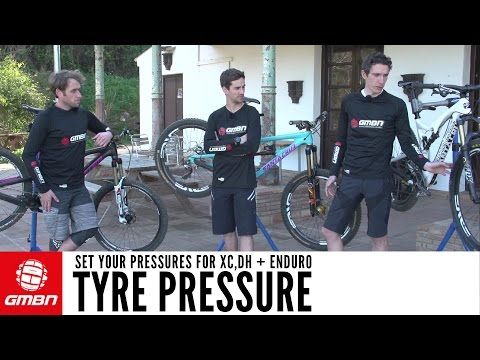 The service life of the bicycle, the speed of riding, the degree of tire wear, safety, control of the two-wheeled friend depends on how the wheels are inflated.
The service life of the bicycle, the speed of riding, the degree of tire wear, safety, control of the two-wheeled friend depends on how the wheels are inflated.
Many cyclists believe that inflating the tires is only necessary for a good bike ride. However, flat tires have a wider area of contact with the road, which means that grip will be better, but it will be very difficult to accelerate to a speed of 30-35 km / h on such tires.
When inflating your tires, you should always consider the type of terrain or surface you will be driving on. If the walk is supposed to be on an asphalt road, the tire pressure of the bicycle should be close to the maximum allowable value. Elastic wheels on a flat surface will provide a smooth rolling and high speed of movement.
For cross-country riding with unpaved paths, it is better to set the tire pressure to medium tolerable, so that you can ride long distances in comfort and convenience. At high pressure, the grip of the wheel with the road will be minimal, respectively, all holes, pebbles, and bumps on the road will be sensitive. And with flat tires, the likelihood of damage to the wheel or puncture of the chamber increases.
At high pressure, the grip of the wheel with the road will be minimal, respectively, all holes, pebbles, and bumps on the road will be sensitive. And with flat tires, the likelihood of damage to the wheel or puncture of the chamber increases.
In order to protect yourself on the road, as well as to keep the bike or its individual parts intact, you need to know exactly the lower and upper limits of permissible values, to what pressure the bicycle wheels can be pumped.
Information about tire pressure gives you an advantage when cycling:

Forget the old "grandfather" way to check the wheel with finger pressure. No need to rely on tactile sensations, trying to feel with your hand the degree of rubber penetration on the tire. The air leaves the wheel gradually, through the pores in the rubber. Within 2-3 weeks, the pressure decreases by 0.1-0.2 atmospheres, but you cannot determine this with your fingers. The exact value at any time will help determine the pressure gauge that every cyclist should have in his arsenal. With its help, it is simple, with a minimum error, the level of pressure in bicycle tires is measured. A pump with a pressure gauge (floor or manual) will become an indispensable tool for cyclists.
There are three standard values in which bicycle tire pressure is measured.
kPa = 14.504 PSI
All these units are used to some extent - in different countries, by different manufacturers.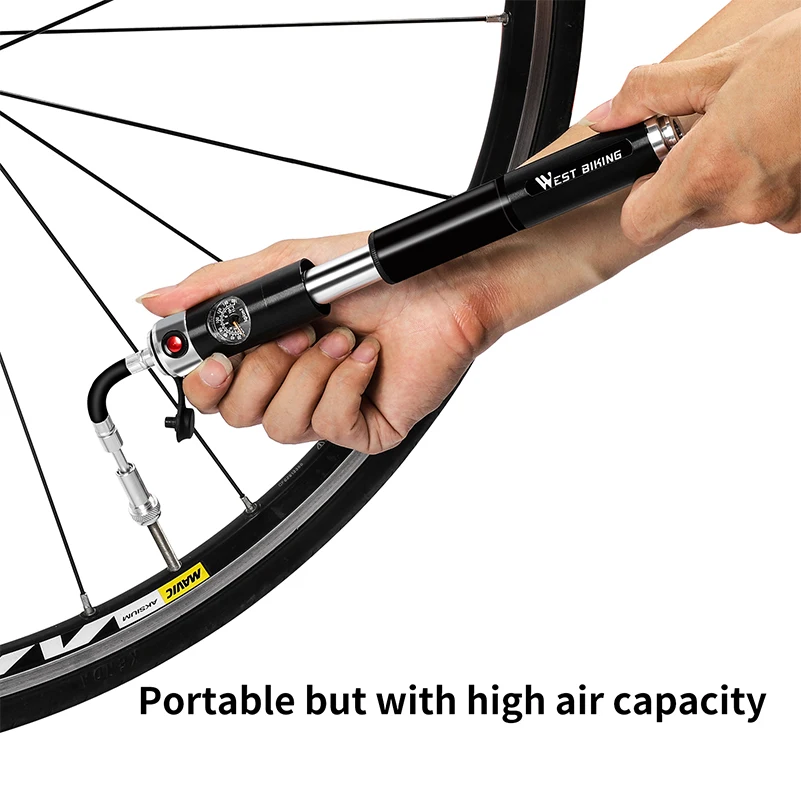 For residents of Russia and the post-Soviet space, the change in bars is more familiar, since this unit is clearly associated with the pressure of the 1st Earth's atmosphere at ocean level. In America and Western Europe, a popular unit is PSI, as they actively use pounds and inches in measurements. Pascals are the least used unit of measurement, but the most modern. Some bicycle manufacturers write data on the wheels about the allowable pressures in all three systems.
For residents of Russia and the post-Soviet space, the change in bars is more familiar, since this unit is clearly associated with the pressure of the 1st Earth's atmosphere at ocean level. In America and Western Europe, a popular unit is PSI, as they actively use pounds and inches in measurements. Pascals are the least used unit of measurement, but the most modern. Some bicycle manufacturers write data on the wheels about the allowable pressures in all three systems.
Manufacturers indicate on the sidewall of the tire how many atmospheres to pump the bicycle wheels. Specifies the range within which the owner of the "iron horse" determines the desired values, depending on the specific factors of riding his bike. Values in the range are labeled from min to max, in two or all three dimensions. Numbers up to 10 are atmospheres (or BAR), tens-hundreds are PSI, and six-digit values \u200b\u200band with the prefix “k” / kilo are Pascals.
When inflating a tire, you must strictly follow the manufacturer's recommendations and try not to go beyond both the minimum and maximum pressure levels indicated on the tire. Moreover, it is better to leave a small margin of 0.2-0.5 BAR, both in one direction and in the other, so that the tire does not burst.
Moreover, it is better to leave a small margin of 0.2-0.5 BAR, both in one direction and in the other, so that the tire does not burst.
The pressure in the wheel is kept by the tire, not the tube, so there is no single standard for its value. There are several significant factors that determine how much you need to pump the wheels on a bicycle.
Tire type is determined by the surface of the track that the cyclist will predominantly ride on. Accordingly, the level of inflation of the bicycle wheel will be different. There is a direct dependence on the roughness of the tread and the width of the wheel - the more lugs and the wider the wheel, the lower the pressure should be. Empirically, cyclists quickly determine how many atmospheres should be in the tires of their bicycle
Many cyclists do not think about the fact that air temperature affects the pressure level in bicycle tires. From the course of school physics, we recall that when heated, bodies expand. This means that in hot sunny weather, the pressure inside the air chamber will increase without additional pumping. Conversely, on cold winter days, a decrease in tire pressure is quickly felt due to low temperatures. So, when going for a bike ride in the cold season, the pressure indicators need to be adjusted a little higher than usual, and in the summer heat, let the air out a little. It is worth noting that when going on a bike ride, you should always take into account the weather conditions.
From the course of school physics, we recall that when heated, bodies expand. This means that in hot sunny weather, the pressure inside the air chamber will increase without additional pumping. Conversely, on cold winter days, a decrease in tire pressure is quickly felt due to low temperatures. So, when going for a bike ride in the cold season, the pressure indicators need to be adjusted a little higher than usual, and in the summer heat, let the air out a little. It is worth noting that when going on a bike ride, you should always take into account the weather conditions.
It is important to consider the load on the bike created by the weight of the rider, especially the fact that most of it is on the rear wheel. Therefore, the degree of its pumping should be slightly higher than the front, the optimal difference is 10%.
To calculate the optimal tire pressure for a bicycle, given the weight of its rider, you can use the table:
Rider weight (kg) Pressure (atmosphere) Pressure (PSI)
The nature, riding style and type of bicycle also affect tire pressure. Buyers who prefer an active pastime often opt for mountain bikes with 26-inch wheels, which ride well both on city streets and in rough terrain.
Buyers who prefer an active pastime often opt for mountain bikes with 26-inch wheels, which ride well both on city streets and in rough terrain.
To understand to what pressure to inflate the wheels of a bicycle, it is necessary to take into account the features of both the bike itself and other, at first glance, weightless factors. For example, weaving threads on a tire, rim thickness, driving style. The likelihood of a tire coming off a wide rim is much less than a narrow rim, because a wider rim will hold the tire better than a thin one. Mountain biking already by its name suggests the presence of a difficult surface on the track, with possible obstacles and bumps. The driving style is more aggressive than on a smooth, calm trajectory, it obliges you to increase the tire pressure to a level slightly less than the upper limit.
The diameter of the wheel will also influence the selection of the optimal pressure value, since the larger it is, the higher the volume of air pumped will be. However, for mountain bikes it is not so important whether the wheel diameter is 26 or 29 inches, it is much more necessary to pay attention to the parameters of the rider's weight and the type of track.
However, for mountain bikes it is not so important whether the wheel diameter is 26 or 29 inches, it is much more necessary to pay attention to the parameters of the rider's weight and the type of track.
There are no hard and fast rules about how much you need to inflate the wheels on your bike. There is common sense, experience, practice. Manufacturers can recommend certain values, but only the owner himself will determine exactly which road he will ride, in what weather conditions he will drive, take into account his weight parameters or not. The decision, what pressure in the wheels will be ideal, is sure to be found.
Every cyclist is obliged to monitor the condition of his two-wheeled horse. It is from this that the envy of its service life and convenience when driving will be. When you go on your next trip, do not forget to measure the pressure in your tires.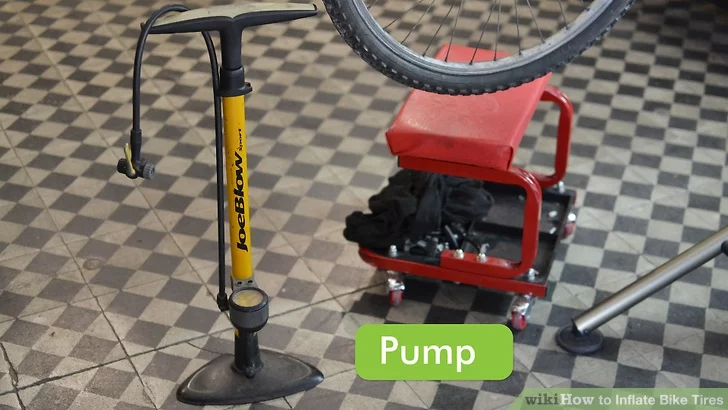 This procedure is mandatory, because it directly affects the comfort while driving.
This procedure is mandatory, because it directly affects the comfort while driving.
Oddly enough, first of all, the quality of cycling, especially on asphalt, depends on the pressure in the bicycle wheels. Under-inflated wheels easily break through and extinguish a large percentage of the efforts of the cyclist, while over-inflated ones can damage the tube and lead to its rapid wear. Accurate knowledge and experience of riding will help you find the golden mean.
Many people are accustomed to checking tire pressure using the old-fashioned method with their fingers. However, this method is very inaccurate, and the concept of a “well-inflated wheel” for each cyclist can be very different. That is why it is always better to have a pressure gauge on hand in order to accurately determine tire pressure.
Its cost is quite low, so everyone can afford such an acquisition.
Contents
In fact, the optimal pressure in the tires of a bicycle is a purely individual parameter that each biker varies within certain limits for himself: according to his riding style, according to the planned track and current level of training. Limits are set by technological restrictions, which we will consider further.
Limits are set by technological restrictions, which we will consider further.
Here are the main factors to consider when choosing the level of inflation:
Considering all the pluses and minuses, one recommendation can be made: the wheels should be inflated enough to provide good traction and not damage the tube. To do this, there are standards for what pressure is considered acceptable. We will consider them further.
If the wheels are overinflated, the bike will have a good roll, but the tire will not absorb at all on uneven surfaces. All difficult sections will be much harder, since the contact patch of the tire with the ground will have a minimum area, and you will be skidded when cornering. Needless to say, when cycling in winter, the situation is aggravated by slippery surfaces. In addition, pumping can cause the wheel to explode. Old Soviet cameras are especially susceptible to this, the material of which is already turning into dust from old age. The tire breaks from excess pressure not immediately, but for example on a hill, where a pebble falls under the wheel. This situation is dangerous because the tire is sometimes literally torn off the wheel.
All difficult sections will be much harder, since the contact patch of the tire with the ground will have a minimum area, and you will be skidded when cornering. Needless to say, when cycling in winter, the situation is aggravated by slippery surfaces. In addition, pumping can cause the wheel to explode. Old Soviet cameras are especially susceptible to this, the material of which is already turning into dust from old age. The tire breaks from excess pressure not immediately, but for example on a hill, where a pebble falls under the wheel. This situation is dangerous because the tire is sometimes literally torn off the wheel.
The air pressure in the tires of a bicycle also affects the "piercing" of the wheel. Pumped rubber easily collects all the carnations and glass on the road.
If the tires are flat, the situation is no better than if the tires are inflated. The tire does not fit snugly on the rim, may come off the wheel, and when driving onto a curb, a puncture may form (the so-called snake bite). The roll of the bike decreases and pedaling requires an increasing amount of force. However, when choosing between an over-inflated tire and an under-inflated one, it is better to opt for an under-inflated tire. But we must not forget about reasonable limits. If the tire drags like a rag, then you clearly made a mistake with the pressure.
The roll of the bike decreases and pedaling requires an increasing amount of force. However, when choosing between an over-inflated tire and an under-inflated one, it is better to opt for an under-inflated tire. But we must not forget about reasonable limits. If the tire drags like a rag, then you clearly made a mistake with the pressure.
The secret of the right choice is very simple: just look at the tire being inflated. Next to the information about the tire size, there will also be information about the allowable pressure range in the chamber.
Why is this information not printed on the camera itself? Because in it the only point that is subjected to real load is the nipple, and its mechanism is very reliable. Otherwise, the normal pressure, which increases by an order of magnitude with fast skating, is taken by the tire, and how much it will be squeezed is the main limitation.
So, at too low a pressure, the tire will break closer to the rim, bite the chamber, leading to breakdown, and at high pressure, it may simply burst on one of the bumps or when driving on hot asphalt.
Since many tire manufacturers focus on the American market, the most common designation is Psi. In English sources, it is usually simplified to “pound”, or pound, that is, when they say that the pressure is 2 pounds, they mean exactly Psi. This unit of measure is obsolete, used only in the USA, but, as they say, "more alive than all living things."
Intelligent pressure sensor data on smartphone screen
Bars are also obsolete units of measurement, but are actively supported in Russia and many other countries, incl. European. This unit of measurement is actively used, as it echoes the “atmosphere”, which is quite convenient for measurements.
Pascal is the only metrically correct unit from the list, but is rarely used in bicycle notation.
The ratio between all units is as follows: 1 Bar = 100,000 Pa = 14. 504 Psi.
504 Psi.
What do they write on tires? For example, (2.38-4.0) is clearly atmospheres, or BAR, and (95-135) is Psi. If the number has more than 3 digits or the prefix "k" (kilo), we are talking about metric Pascal. Most often, the desired value is located under the size designation and is duplicated in BAR and Psi as a range, clearly indicating to what pressure you can pump.
Actually, the manufacturer indicates the range within which the tire can function, further - the freedom of the cyclist.
Manufacturers indicate the recommended parameters on the side of the tire. Usually they are in the range of 35 - 60 psi (2.38 - 4.08 atmospheres). But still, this is a parameter that is selected purely individually. Therefore, there are a number of recommendations that are considered common to all people.
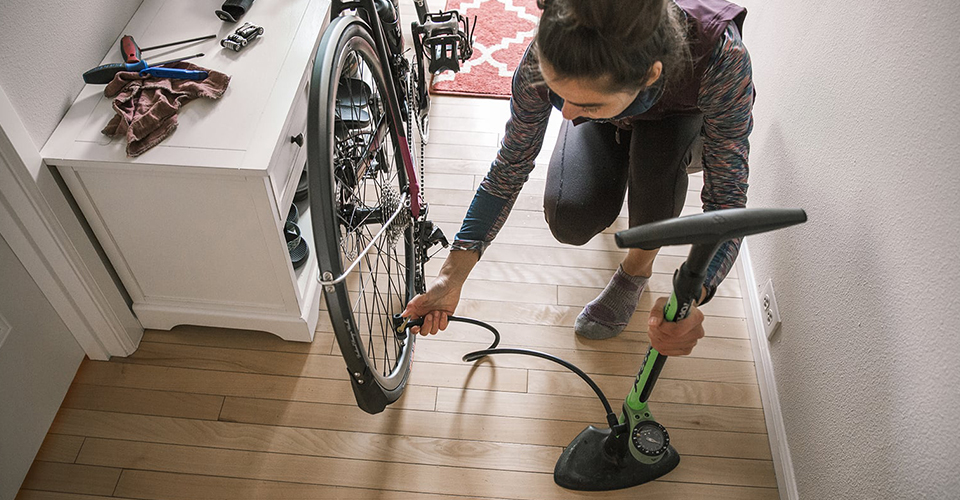
Important! With poorly inflated bicycle tires, the tire will move towards the rim, wringing the chamber. This will deform the wheel.
When the cyclist is training on relatively smooth asphalt roads, country and forest dirt roads and paths. For this style of riding, I prefer to inflate the wheels to 3.5-4 atmospheres. Such a high value of bar allows you to achieve good speed characteristics, high rolling, but when it hits bumps and stones, the fifth point immediately feels all the bumps in the road surface.
For those who like pleasure riding at low speed on smooth park roads, 2.5-3 atmospheres will be enough. On the Internet, you can often find recommendations to pump 2-2.5 bar into the wheels, this is justified only for tires at least 2 inches wide and when driving on rough terrain or poor coverage.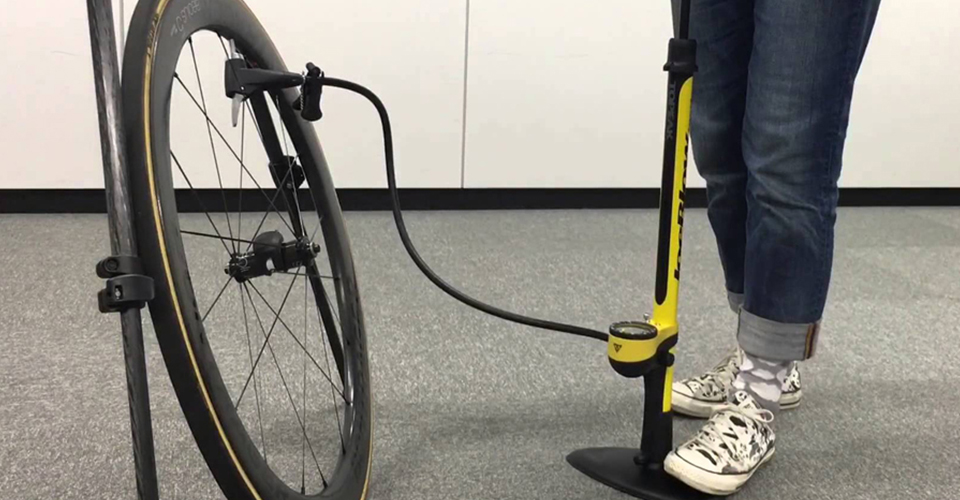 Low pressure increases traction and comfort, but reduces rolling on smooth pavement. Under no circumstances should you ride at a pressure of less than 2 atmospheres.
Low pressure increases traction and comfort, but reduces rolling on smooth pavement. Under no circumstances should you ride at a pressure of less than 2 atmospheres.
The choice of terrain on which you prefer to ride obliges you to choose a certain type of tire, but in general, if you have a universal tread, you can make your ride comfortable on a particular type of road surface by changing the amount of wheel atmospheres. The figures below are based on a standard 2-2.1″ tire.
For gravel, mud, grass, sandy surfaces, it is better to inflate up to 2.5 atmospheres, which increases the adhesion of the tread to the ground and allows the wheel to smooth out all the unevenness of the road surface quite well.
For smooth asphalt roads, feel free to use a pressure of 3 bar or more. However, there is one thing here. If you have a fairly bald tread (wheels with a weak relief or slicks), and you drive at high speed on wet or even wet asphalt, then you risk slipping (flying out) on a turn. If it rains on the road, just slow down or deflate the tires slightly.
If it rains on the road, just slow down or deflate the tires slightly.
This article describes the most acceptable criteria for choosing tire pressure, but since each person independently selects the most convenient pressure values, I advise you, first of all, to experiment when mastering a bicycle.
The bicycle inner tube requires maintenance and pumping very often. Even on the most “hardy” city and mountain bikes, it is necessary to check and pump up the chamber once every 2-3 weeks, since air leaks not only through the nipple, but simply through the rubber. The high pressure "helps" the air molecules to find their way through the insufficiently dense chamber.
"City" or, simply, budget bikes, it is enough to inflate once every 2-4 weeks, mountain bikes - at least once every two weeks, road bikes - once a week, and road and sports bikes - before each trip.
Therefore, the pump is not only an emergency accessory, which is used only when a punctured tire is changed, but also a necessary part of preparation for departure.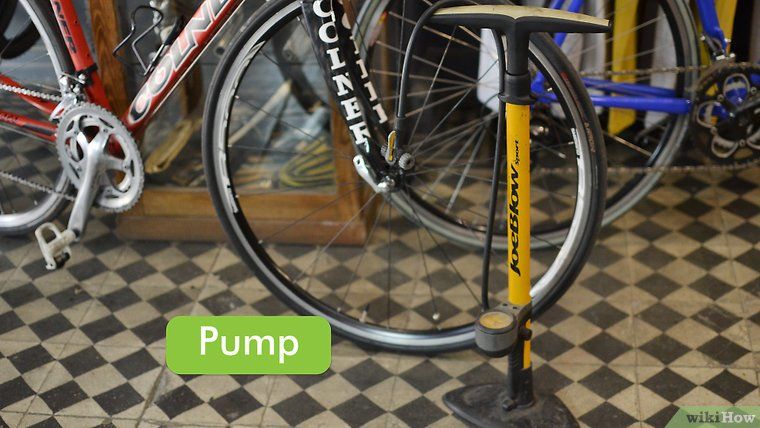 Active cyclists should consider purchasing two pumps:
Active cyclists should consider purchasing two pumps:
By the way, the place of a stationary pump is perfectly occupied by an ordinary car pump. It is also suitable for bicycles, it shows exactly how many atmospheres are inflated, and does not take up extra space. Some people prefer to pump up on "professional" pumps at gas stations, but not having their own professional tool can play a bad joke in case of an unexpected situation or when deviating from the standard route.
Here are some tables that will help you navigate in difficult situations, namely:
Mountain bike table:
| Rider weight (Kg) | Pressure (BAR) | Pressure (Psi) |
| 50 | 2,38-2,59 | 35-38 |
| 63 | 2,52-2,72 | 37-40 |
| 77 | 2.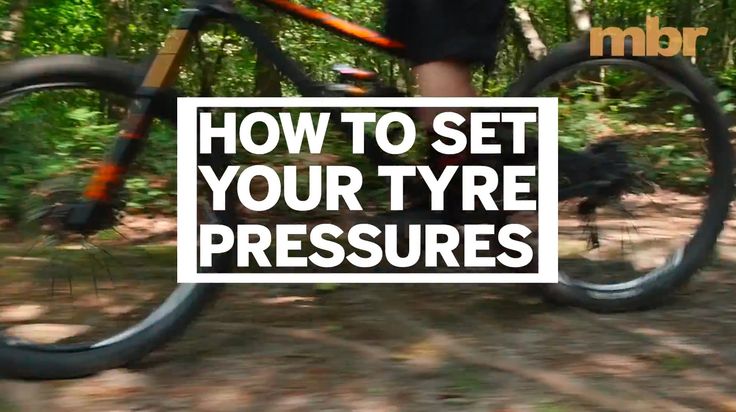 72-2.93 72-2.93 | 40-43 8 |
| 91 | 2.86-3.06 | 42-45 |
| 105 | 3.27 | 45-|
| 118 | 3.2 - 3.4 | 47 - 50atmospheres (up to 130 Psi), up to the maximum specified by the manufacturer. Children's bicyclesFor children it is better to inflate tires to the maximum permitted value. This will make it easier to learn to ride a bike, as well-inflated tires have a smaller contact patch and require less effort for the rider. Seasonal changesSeasonal adjustments are quite serious, mainly for mountain bikes. In the summer, you should slightly underestimate the pumping and not rest on the maximum. Hot asphalt also heats the air inside the chamber, which increases the volume and, consequently, the pressure. Also, the pumped tire wears out very quickly. In winter, sometimes the maximum should be slightly exceeded in order to achieve maximum tread work, especially if the rubber is chosen with studs. Weight ChangesFor heavy riders or heavily loaded bikes, adding pressure is very important, as more weight will compress the bike's wheel and under-inflated problems can come out much sooner. The recommended pressure to add by weight is +1% for every kilogram of rider weight over 50. Approximate values by type of rubberOptimizing the level of inflation of bicycle tires depends on the type of bicycle rubber used, in particular mainly on the type of tires. If the bike is "shod" in slick or semi-slick rubber, then minimizing pressure is only permissible on hot days. As bench tests of slick (low-relief) tires have shown, reducing the level by 25.0% to the optimal level nullifies all their advantages. You can also give advice on how to inflate wheels with different tires. If the bike is "shod" in tires 2.0 ... 2.3 inches wide with cross-country treads, then the optimal pressure range is 3. Extreme riding tires (Downhill/Slalom 24″×2.10 or Kenda K905 20 x 1.95″) with compound tread, best inflated to medium recommended pressure. This will provide the necessary grip on the supporting surface. In the future, its indicator can be adjusted for specific driving conditions. BMX trick models should be moderately inflated, between maximum and minimum, in order to have sufficient traction, and then subtly varied for each trick. For winter skiing, you should choose a pressure slightly higher than normal, since at sub-zero temperatures the air in the tire becomes denser and takes up less space. How to check the pressure after inflation The exact value can only be checked with a pressure gauge. Experienced cyclists can read pressure by eye. You can inflate tires with a pressure gauge, memorize the value and squeeze the tire with your fingers. Remember the feeling, so you will learn to understand how inflated your wheels are. DeterminantsDespite manufacturers recommendations, wheel chamber pressure is a matter of personal preference. Each cyclist adjusts this parameter for himself, for the track he is going to ride, for his personal riding style and level of technical training. Therefore, how much should be pumped up, everyone decides for himself. Every experienced rider knows a number of factors and operates with them:
ConclusionBicycle tire pressure is a very important parameter, you need to understand what limitations are imposed by tire manufacturers and what style of riding a particular rider can be improved with just a couple of movements of the pump knob. In any case, how many atmospheres to pump at each moment is a unique decision, and it is made more on the basis of accumulated experience than according to strict rules. VideoQ&AWhat is the pressure in the bicycle tires? At 50 kg (110 lb) - 2. mountain bike tire table bar? The tire pressure of the mountain bike must be between 2.4 and 4.5 bar. What is the tire pressure on a road bike? Expensive quality road bike tires 21-23mm should have a pressure of 10-11 atmospheres. In wider or lower quality pressures are lower, the maximum value is always indicated on the sidewall. It must not be exceeded, it is advisable to maintain it before each ride. What is the optimal tire pressure for a fatbike? 10 PSI - Rolled snow, paths
1 psi = 0. |